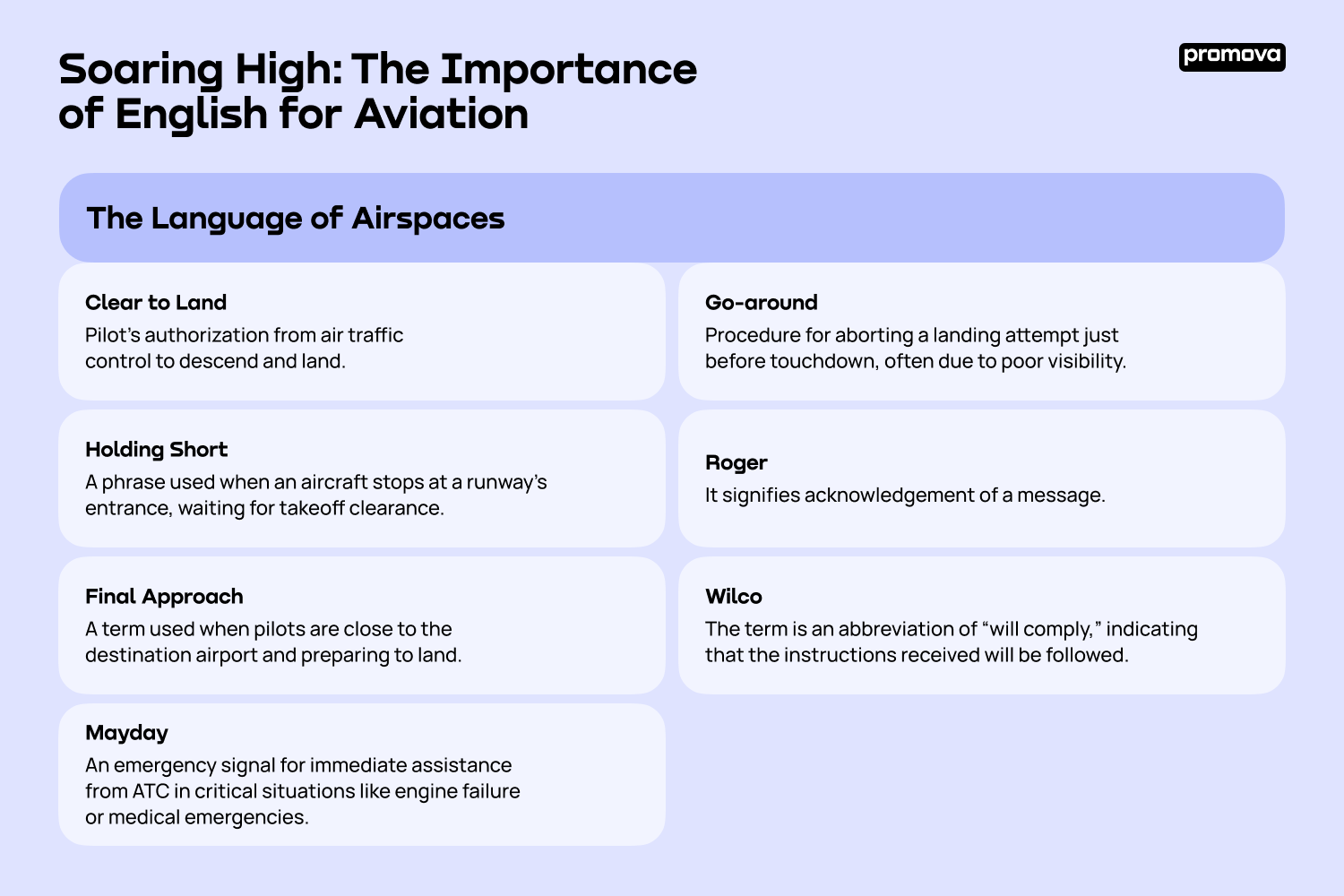Soaring High: The Importance of English for Aviation

Contents
With its promise of connecting distant lands, air travel is propelled not just by jet engines but also by a linguistic bridge – English. The successful coordination of countless flights daily relies on the capacity of pilots and aviation staff to speak and understand the language. Join us as we embark on a journey through the vital role of English for aviation and why it is so crucial. We will also explore the challenges non-native speakers face in this field and what measures can ensure effective communication.
The Lingua Franca of the Skies: English for Pilots, Air Traffic Controllers, and Aviation Staff
In the diverse realm of the aviation industry, English holds the fort as the lingua franca. This common language enables seamless communication among pilots and air traffic controllers. This linguistic harmony is not coincidental but a deliberate initiative by the global community.
For pilots, English extends beyond basic conversation, including specific terms and phrases. Pilots rely on a shared understanding of aviation vocabulary and communication protocols, from pre-flight checks to landing procedures. English for air traffic controllers is just as profound. They safely guide numerous aircraft, often from different countries, through their airspace. Using a standardized language is vital to providing clear instructions, avoiding misunderstandings, and maintaining safety.
English proficiency standards are critical criteria in aviation. Recognizing that not all personnel will be native speakers, certain proficiency levels have been stipulated, especially for pilots and air traffic controllers. These standards are set by the International Civil Aviation Organization (ICAO).
However, while English is the standardized language in aviation, the industry also acknowledges the multilingual capabilities of its personnel. In cases where both the pilot and the controller are native speakers of the same language, they may choose to communicate in their mother tongue. But, should the conversation involve a non-native speaker, an immediate switch to English is required.
The Historical Evolution of the Aviation English World
Tracing the historical trajectory of English provides valuable insights into the language’s unique adaptations to suit the dynamic needs of the aviation world. At the dawn of aviation, there was no standard language. But as air travel transcended borders and continents, miscommunication emerged as a potentially catastrophic problem. The journey of Aviation English development can be broken down into three crucial stages:
- Birth of Aviation English. When commercial aviation started in the early 20th century, the importance of a common language was recognized. With its widespread use, the language began to assert dominance, aided significantly by the influence of the United States and the United Kingdom in aviation advancements.
- Standardization by ICAO. The ICAO’s decision in 2008 to enforce English proficiency requirements for all personnel was a defining moment. English became the officially recognized language for global aviation communication.
- Evolution and specialization. Aviation technical English has evolved into a specialized language subset over the years, consisting of unique terminologies, phrases, and sentence structures. It’s designed to convey maximum information quickly, with clarity and precision.
Understanding the unique evolution and current language usage is essential for those aspiring to enter the aviation industry. It helps appreciate the nuances that set Aviation English apart from general English, paving the way for effective learning strategies.
The Language of Airspaces: Understanding Terminology and Slang
Aviation English is a specialized language subset imbued with unique terminologies and slang. Its purpose is to ensure mutual intelligibility among pilots, air traffic controllers, and other personnel, irrespective of their native language. A few examples of standard phrases are as follows:
- Clear to Land. Pilot’s authorization from air traffic control to descend and land.
- Holding Short. A phrase used when an aircraft stops at a runway’s entrance, waiting for takeoff clearance.
- Final Approach. A term used when pilots are close to the destination airport and preparing to land.
- Mayday. An emergency signal for immediate assistance from ATC in critical situations like engine failure or medical emergencies.
- Go-around. Procedure for aborting a landing attempt just before touchdown, often due to poor visibility.
- Roger. It signifies acknowledgement of a message.
- Wilco. The term is an abbreviation of “will comply,” indicating that the instructions received will be followed.
Besides these phrases, basic Aviation English also employs a distinct pronunciation system for numbers to prevent misunderstandings. For instance, ‘1’ is pronounced as ‘wun,’ ‘3’ as ‘tree,’ ‘4’ as ‘fower,’ and ‘9’ as ‘niner.’

The language of airspaces is further enriched by its collection of slang or jargon, which often has roots in pilot humor, historical events, or the need for brevity. Although not officially recognized, the aviation community commonly understands these words and phrases. Here are a few examples:
- Greaser. It refers to an exceptionally smooth landing.
- Blue juice. This phrase is the slang term for the fluid used in airplane toilets.
- Crabbing. It describes pilots’ technique to keep the plane’s path aligned with the runway when facing crosswinds during landing.
Using aviation terminology and slang can create a sense of camaraderie among pilots and air traffic controllers. However, there is an important distinction to be made. While casual conversation can tolerate ambiguity, in aviation, ambiguity can lead to catastrophic results. So informal language is highly discouraged during critical communications, such as between pilots and air traffic controllers during flights. The standard vocabulary of Aviation English has been carefully developed to minimize misunderstandings.
Aviation English Training: Strategies to Master the Language
Mastering the aviation language, with its distinctive vocabulary and phraseology, requires targeted learning approaches beyond traditional instruction. Here are some key strategies:
- Familiarize yourself with the vocabulary. Start by immersing yourself in the specific terminology used in the aviation industry. It could involve studying pilot manuals, listening to air traffic control communications, and reading about aviation.
- Practice radiotelephony conversations. Listening to live air traffic control (ATC) communications and role-playing conversations between ATC and pilots can significantly enhance your understanding and fluency.
- Use learning resources. Numerous online resources, including training courses, textbooks, and apps, are designed to help learners master the language systematically. The ICAO even has an online Aviation English language test service. Also, Aviation English by Macmillan is a comprehensive coursebook that can help accelerate your learning.
- Listen and repeat. Listening to native speakers, particularly air traffic controllers, and pilots, and repeating what they say, can help you perfect your pronunciation and accent.
- Stay updated. Aviation is a dynamic industry, with regulations, technology, and even language changes. Staying updated with industry news will help you keep your language skills current.
Remember, the ultimate goal of mastering Aviation English is to communicate effectively and ensure safety in all operations. So, focus on precision and clarity in all your communications. Teaching Aviation English is a specialized discipline, and many flight schools worldwide offer it as a separate course to ensure that aviation professionals have the requisite language skills.
7
Promova – Your Ultimate Language Learning Companion
Learning a new language online can be overwhelming, but it becomes much more manageable with Promova by your side. Our comprehensive platform offers a range of tools and resources to help you master any language quickly, efficiently, and confidently.
With Promova’s app available on all major mobile devices, you can access personalized classes with certified tutors at your convenience. Our professional educators are experienced in teaching learners of all levels, from beginners to advanced speakers who want to fine-tune their skills. In addition to group classes, we provide one-on-one online sessions tailored to your needs and learning style.
Promova also offers an interactive learning experience through quizzes, word lists, and listening activities that help you practice your skills at your own pace. Conversation Club, a community of language enthusiasts worldwide, is another excellent feature that helps to work on your speaking skills and get feedback from peers.
And our blog offers informative articles with engaging content on various topics related to language learning. We cover everything from difficult English words to helpful grammar tips and practical advice on preparing for exams or job interviews in a foreign language.
Conclusion
Mastering general English for aviation paves the way for seamless communication in the global aviation industry. Whether you’re an aspiring pilot, air traffic controller, or simply a part of the staff, fluency in this language opens the door to career advancement, improved operational efficiency, and, above all, enhanced safety. Armed with the right strategies and tools, your journey through the language of the skies can indeed be a rewarding one.
FAQ
How does Aviation English differ from standard English?
It is a unique subset of the English language that shares standard grammar and vocabulary but includes specific terminology, standardized phrases, and pronunciation guidelines. These adaptations promote accurate, swift, and unambiguous communication in aviation’s dynamic and high-stakes environment.
Does an accent matter in Aviation English?
While a neutral accent is preferred to facilitate mutual understanding, the emphasis is more on clarity and correct pronunciation. If the pilot can speak clearly and pronounce words accurately, their accent will unlikely cause communication issues in aviation.
Can a person be a pilot if they’re not fluent in English?
Fluency is crucial for pilots due to ICAO’s language proficiency requirements. However, non-native speakers can become pilots with dedicated learning and practice.
How does one maintain proficiency in Aviation English?
Maintaining proficiency requires consistent practice and exposure to the language. Pilots, air traffic controllers, and staff can participate in training programs specializing in Aviation English or attend refresher courses periodically.
Comments